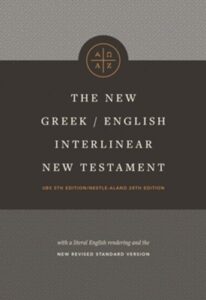the Greek/English Interlinear New Testament
 An interlinear New Testament provides a word-for-word translation from the Greek to English, with both versions appearing together on the same page. An interlinear can be useful for understanding how a particular passage was constructed in the original Greek. It isn’t recommended for regular reading, because Greek sentence structure can seem awkward and misleading to people who know only English.
An interlinear New Testament provides a word-for-word translation from the Greek to English, with both versions appearing together on the same page. An interlinear can be useful for understanding how a particular passage was constructed in the original Greek. It isn’t recommended for regular reading, because Greek sentence structure can seem awkward and misleading to people who know only English.
For example, the RSV translates this familiar passage from John 3:16 into English as: “For God so loved the world that he gave his only-begotten Son, that whoever believes in him should not perish but have eternal life.” Tyndale’s The New Greek-English Interlinear New Testament gives a word-for-word translation for the same passage as: “FOR THUS LOVED GOD THE WORLD, THAT THE SON, THE UNIQUE ONE, HE GAVE, THAT EVERYONE BELIEVING IN HIM MAY NOT PERISH BUT HAVE LIFE ETERNAL.
Note that interlinear Bibles render the text in capital letters. The Bible originally was written in all capital letters. Use of upper and lowercase letters is a later development.
 learn more about words in the Bible
learn more about words in the Bible
Lost in Translation is a weekly e-column about biblical translation written by  Turning to God’s Word author Matthew Phelps. You can visit our searchable archives on our Lost in Translation page to read Matthew’s past entries about the original meaning of words used in Scripture. New entries are posted every Monday. If you’d like to receive a copy of Matthew’s Lost in Translation by email each week, use this link to let us know.
Turning to God’s Word author Matthew Phelps. You can visit our searchable archives on our Lost in Translation page to read Matthew’s past entries about the original meaning of words used in Scripture. New entries are posted every Monday. If you’d like to receive a copy of Matthew’s Lost in Translation by email each week, use this link to let us know.
